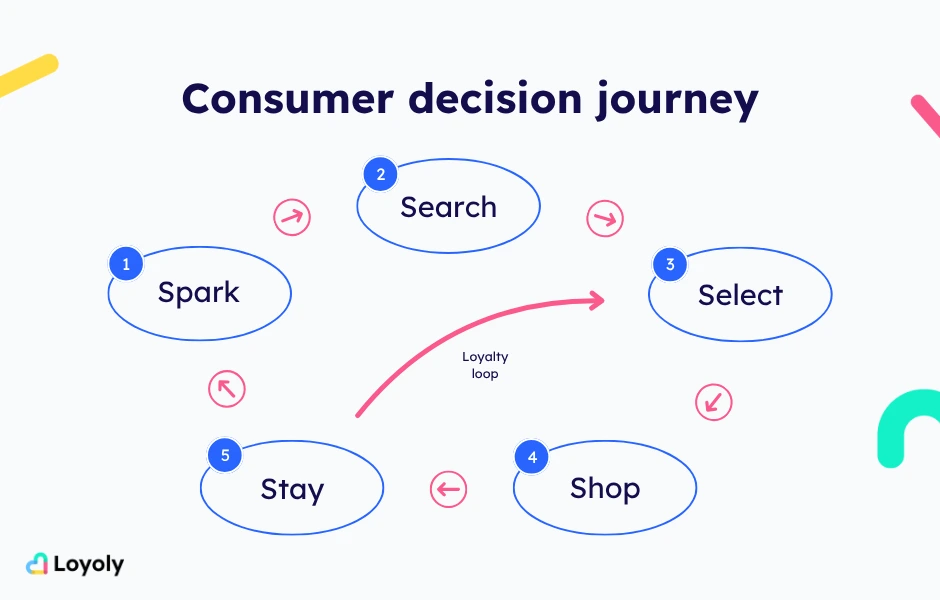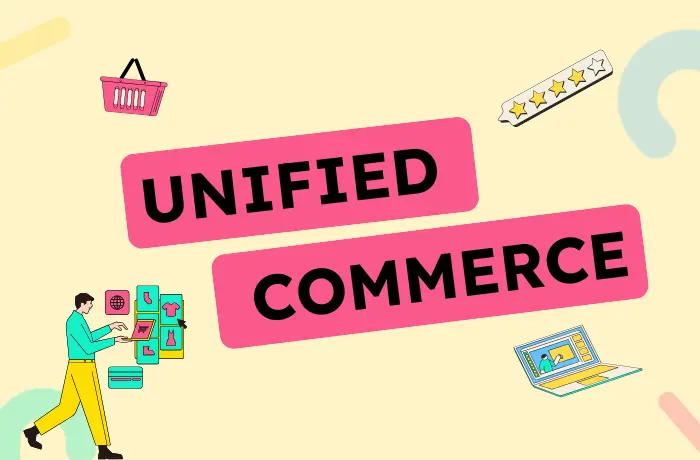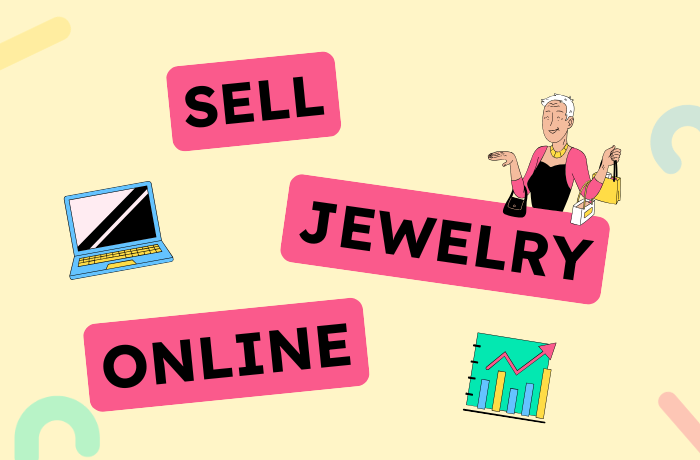How do people really decide to buy from your brand?
Spoiler: it’s not just about getting them to click “Add to cart.”
In ecommerce, success isn’t driven by guesswork, it's about understanding how consumers really behave.
From the initial spark of interest to the final sales outcome (and everything in between), their decisions are shaped by dozens of digital and online interactions.
Modern companies can’t afford to rely on outdated funnels.
They need a clear view of the real path people take one that includes exploration, hesitation, feedback, and even advocacy.
This is where the Consumer Decision Journey (CDJ) becomes essential.
For marketers, it’s a powerful tool to turn insights into action.
For management and business leaders, it’s a way to align teams around what actually drives growth not just acquisition, but loyalty and influence.
What is the consumer decision journey?
The Consumer Decision Journey, or CDJ, is a framework built to decode how consumers really behave from that first spark of interest to the moment they become repeat buyers and advocates.
It goes way beyond the first click or the checkout page.
Unlike the classic funnel model, the CDJ zooms in on what happens before, during, and after the purchase, offering a much richer approach to understanding intent and loyalty.
Grounded in behavioral research and inspired by the McKinsey circular model, this framework sheds light on the key drivers of consideration and engagement.
What kind of information do people need to feel confident?
Which signals push them to compare products or explore alternatives?
What convinces them to say yes and to say yes again later?
This isn’t just theory. It's a practical approach that helps brands adapt their marketing to real-world behavior.
By layering your strategy with insights drawn from McKinsey's work and your own research, you can meet consumers where they are whether they’re actively searching or passively discovering your products through peer recommendations.
The result? Sharper marketing, smarter consideration touchpoints, and a journey built on useful information rather than assumptions.
Because when your model reflects how decisions actually happen, you stop pushing and start guiding.
That’s what a customer-centric framework really looks like.
👉 Extend the reflection on the ecommerce in 2025 with the explanations of an expert in this video (french with english subtitles)
Why the model had to evolve
The classic funnel had its moment, but let’s face it : it no longer reflects how people actually make decisions.
It assumes a linear, predictable process: see an ad, click, convert.
Simple.
But in today’s digital landscape, that’s rarely the case.
The modern consumer journey is fragmented, messy, and deeply online.
Someone might spot your product in a TikTok video, do an initial Google search, scroll through YouTube reviews, compare prices on another tab, then bounce to Instagram before finally acting on a promo code from your last email.
These digital behaviors shape not only what people buy, but how and when they buy it.
That’s why the new Consumer Decision Journey (CDJ) emerged it’s built to match reality.
Unlike the funnel, the CDJ doesn’t stop at purchase. It accounts for everything after: delivery, onboarding, support, reviews, referrals every moment that can influence the next step.
Because in truth, today’s decisions aren’t made in a vacuum.
They’re made through a series of micro-moments across multiple channels and devices.
Models like McKinsey’s CDJ or the idea of loyalty loops capture this evolution perfectly.
People don’t move forward in straight lines, they loop, pause, revisit, and re-engage.
If your strategy only focuses on the conversion, you’re missing a massive chunk of the value chain.
The CDJ isn’t just a new diagram, it's a mindset shift.
It’s about adapting to how online behavior really works and using that insight to create better experiences, stronger relationships, and lasting brand growth.
5 reasons why the CDJ should be at the core of your ecommerce strategy
If you're still building your strategy around a funnel, you're missing the point.
This approach isn’t just more realistic.
It’s more effective.
It helps you align your content, your teams, your KPIs, and your growth tactics with how people actually behave.
Here’s why the CDJ should be at the heart of your ecommerce game plan.
👉 Discover how experience influences every decision with our dedicated article.
It mirrors real behavior
People don’t shop in straight lines.
They discover your product in a TikTok, open five tabs, compare prices, check Instagram, get distracted, and maybe come back days later after seeing a retargeting email.
The funnel doesn’t capture any of that.
The CDJ does.
It helps you map those unpredictable paths and show up consistently at each step.
The result is more relevance, more trust, and better performance across every touchpoint.
It connects the entire journey
The CDJ helps you think beyond acquisition.
It forces you to consider the full experience.
That includes everything from the first moment someone hears about your brand to how they feel after their second or third order.
When you build for the whole journey, you stop thinking in silos.
Awareness connects with conversion.
Post-purchase connects with retention.
Everything starts working together, and your customer experience becomes smoother, smarter, and more memorable.
It aligns your entire team
Great customer journeys don’t happen in one department.
They come from collaboration.
The CDJ gives every team a shared reference point.
Marketing understands which content drives action.
CX knows when to engage.
Product sees where user feedback matters most.
Even logistics starts to play a role in loyalty.
When everyone’s aligned on how the journey flows, it’s easier to build a brand that feels consistent, clear, and trustworthy.
It lifts every performance metric
When you activate the full journey, your results improve across the board.
Your conversion rates go up because the buying experience is smoother.
Your LTV increases because people stick around.
Your CAC drops because happy customers bring in new ones through referrals or content.
It’s not just about driving more transactions.
It’s about building a system that naturally improves every lever of growth.
👉 Explore our comprehensive guide on the LTV/CAC ratio.
It makes your marketing smarter
The CDJ helps you stop wasting time and budget on disconnected campaigns.
Marketers can understand where people hesitate, where they drop off, and where you can make the biggest impact.
You can finally match your content and incentives to what your audience actually needs, right when they need it.
That means better ROI, stronger engagement, and a strategy that keeps improving over time.
The 5 key stages of the consumer decision journey
Buying journeys aren’t clean or linear.
People jump around, repeat steps, pause, and come back later.
At Loyoly, we’ve defined five clear stages, the 5S, that reflect how real shoppers move today.
Each step has its own logic.
Your job is to understand what happens there, and what drives people forward.

1. Spark
This is where the journey really begins. It’s the moment someone becomes aware of a need, a frustration, or a desire.
They might not know what they’re looking for yet, but something shifts in their mind.
A pain point shows up.
A goal gets clearer.
A problem becomes too annoying to ignore.
They realize there’s something missing or something worth improving.
Maybe their water bottle always leaks in their bag.
Maybe their skin feels dry no matter what they try.
Maybe they just moved and need to furnish their apartment.
Whatever it is, a switch flips and they become open to change.
What actions should be taken?
- Educational or problem-aware content (SEO blog posts, TikTok "you might need this if..." style)
- Creator partnerships focused on real-life situations or pain points
- Paid social campaigns targeting interests or behaviors, not just demographics
- Quizzes or interactive tools that highlight a need the user might not have identified yet
- Word-of-mouth or referral triggers (e.g. “a friend had the same issue and found this”)
2. Scan
Now that the user is aware of a need or problem, they start actively looking for ways to solve it.
This phase is all about research.
People compare options, gather information, and try to make sense of what's out there.
They might start Googling, scrolling through review sites, asking friends, or checking TikTok and Reddit for real-life feedback.
They’re not ready to buy yet, but they’re building a mental shortlist.
They want to feel informed, confident, and reassured.
Your prospects can compare 3–5 skincare brands for dry skin.
Or they are browsing YouTube for reviews of leak-proof water bottles.
Or eventually they'll read blog posts about how to furnish a small space on a budget.
Whatever the path, they’re collecting data and narrowing the field.
What actions should be taken?
- Long-form blog posts or product guides that explain options clearly
- UGC and creator content showing real use cases and benefits
- Product reviews, ratings, and customer stories displayed on-site
- Email flows offering checklists, guides, or product match tools
- Retargeting ads that highlight product differentiators or social proof
3. Select
At this stage, the user is ready to decide.
They’ve done their homework, filtered out the noise, and are weighing their top options.
This is when emotions and logic collide.
They assess trust signals, compare features, double-check return policies, and look at shipping times.
It’s about feeling confident in the purchase decision.
They want to know they’re making the right call.
A great product matters, but so does service, clarity, and reassurance.
Everything needs to be frictionless : price, benefits, past reviews, even the design of the checkout page.
What actions should be taken?
- Clear and persuasive product pages (value, benefits, guarantees)
- Comparison tables to simplify decision-making
- Urgency tactics like low stock alerts or limited-time deals
- Live chat, customer service access, or detailed FAQs
- Strong social proof (UGC, reviews, influencer quotes)
4. Shop
This is the moment they hit “Buy now.”
But it’s not just about the transaction. It’s about how that moment feels.
Is it smooth? Reassuring? Fast? Exciting?
If anything goes wrong here (confusing payment screens, hidden fees, unexpected delays) you risk losing them at the finish line.
This is the point where everything must click: trust, speed, and clarity.
What drives the Shop stage is confidence.
Confidence that the product is right, the site is secure, the brand is reliable, and the experience will be seamless.
The fewer the doubts, the better the conversion.
What actions should be taken?
- Streamlined checkout process (no unnecessary steps)
- Multiple secure payment options
- Mobile-friendly checkout UX
- Clear confirmation and delivery info at purchase
- Cart abandonment emails or SMS for follow-up
- Loyalty incentives or discounts at checkout to boost retention
5. Stay
This is what turns a first-time buyer into a loyal customer.
The decision journey doesn’t end at the purchase.
In fact, this stage is where long-term value is built.
Stay is about how someone feels after they’ve received and used the product.
Did it meet their expectations?
Were they surprised in a good way?
Did they feel seen, appreciated, or forgotten?
At this stage of the consumer decision journey (CDJ), what drives behavior is satisfaction, relevance, and connection.
A great post-purchase experience builds trust, increases retention, and fuels repeat purchases.
Loyalty doesn’t happen by default, it’s earned through consistent service, useful communication, and ongoing value.
What actions should be taken?
- Post-purchase emails to thank and onboard
- Loyalty programs rewarding repeat purchases
- Customer service that's fast, friendly, and easy to reach
- Personalised offers based on purchase history or preferences
- Educational content or how-to guides to make the most of the product
- Referral campaigns to drive word-of-mouth from happy users
- NPS or satisfaction surveys to identify promoters and pain points
Once someone becomes truly loyal, their journey looks very different.
They often skip the Spark and Search stages entirely.
They already know you, trust you, and want to come back.
So they go straight to Select and Shop, no hesitation, no comparison.
That’s the power of loyalty: it turns repeat purchases into reflexes.
Pssst... You might find this interesting!
Loyalty programs are strategic for your brand, and we can probably help. Check out our platform!
3 steps to leverage your customer decision journey
Understanding the consumer decision journey is one thing. But to actually make it work for your brand, you need to turn it into action. Here are three simple (and powerful) steps to bring it to life in your marketing strategy.
1. Map the journey
Knowledge is power.
Before you optimise anything, you need to see the full picture.
Mapping the customer decision journey (CDJ) helps you understand how people actually experience your brand from first contact to long-term loyalty.
Start by combining data and conversations.
Look at your analytics (Google Analytics, CRM, heatmaps) to find quantitative trends: cart abandonment, bounce rates, time to reorder, churn.
Then pair that with qualitative insights : talk to customers.
Run interviews, surveys, or review support tickets.
Ask what they were trying to do, what frustrated them, and what made them move forward.
Visualise everything
Use Miro, Figma, Lucidchart – whatever helps you map out the real decision paths.
Highlight where people hesitate, drop off, or rave.
And most importantly, don’t do this alone.
Involve marketing, product, and customer experience teams.
Everyone owns a piece of the journey.
A good CDJ map aligns them on the same goal: making that experience smoother, faster, and more relevant.
This step helps you identify the real bottlenecks not just at checkout, but across the full decision process.
What to track during journey mapping
- Drop-off points (cart abandonment, bounce rate, exit pages)
- Repetitive touchpoints (looping between product pages and FAQ, etc.)
- Confusion points (UX friction, unclear value prop, too many steps)
- Gaps between acquisition and activation (e.g. traffic from Instagram not converting)
- Missing content during consideration (no social proof, no reviews, no comparison)
2. Turning insight into action at every stage
Now that you’ve mapped your consumer decision journey, the next step is orchestration.
It’s not just about what people do at each stage, but what you should do in return with intention, consistency, and timing.
Here's how to turn each moment into a performance lever:
Spark
Identify friction or desire early and position your brand as the solution before the search even begins.
Scan
Guide the exploration. Curate, simplify, and surface what matters most for each audience segment.
Select
Remove doubt. Add trust signals, social proof, and clarity to help them choose you with confidence.
Shop
Make buying effortless. Shorten paths, reduce friction, and offer reassurance right when it counts.
Stay
Keep delivering value. Surprise, reward, and involve your customers so they stick around and talk about you.
The goal is consistency.
Your messaging, tone, and brand experience should feel fluid across channels, but also intentionally adapted to the mindset of your customer at that moment.

3. Use data to optimize continuously
The Consumer Decision Journey isn’t static.
Your users evolve, your channels change, and what works today might flop tomorrow.
That’s why data isn’t just helpful : it’s essential.
Start by tracking where people drop off or loop back.
Are they bouncing after the homepage?
Abandoning carts?
Ignoring post-purchase emails?
Each behavior tells you something about a broken link in your journey.
Then, test. A/B test your headlines, CTAs, email timings, landing pages whatever touchpoint matters at each stage.
The goal isn’t just higher conversion, but smoother progression through the journey.
Finally, dig into behavioral data and attribution.
What channels drive action?
What content leads to repeat purchases?
Insights like these help you refine the full experience, not just the front end.
Think of it as a cycle. Map, align, measure. Then start again.
How Loyoly fits into your consumer decision journey
Loyoly plugs directly into each stage of the journey.
From first impression to long-term loyalty, it helps you turn passive browsers into active brand advocates.
- Spark interest early by turning your happiest customers into your best creators.
- Reward them for posting, tagging, or reviewing your products on TikTok or Instagram.
- Build brand visibility through UGC and earned media, no better way to stand out to potential consumers than with real people sharing real experiences.
- Increase confidence at the decision stage by displaying authentic reviews, before/after shots, and short-form testimonials all collected through automated missions.
- Boost conversions by offering post-checkout incentives: refer-a-friend codes, exclusive community access, or VIP perks that nudge them to come back.
- Collect feedback at scale right after purchase, when engagement is high like review requests, satisfaction surveys, or quick polls.
- Encourage repeat purchases with tiered loyalty rewards : the more they buy, the more simple and effective.
Every touchpoint becomes an opportunity to engage, convert, and retain without needing 5 different tools to do it.

.png)









.png)
.png)
.png)
.png)
.png)